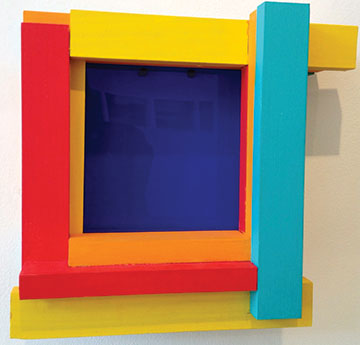Next story: Acting at the Shaw Festival: Wade Bogert-O'Brien
Hatchett Job
by Jack Foran



David, Dana, and Duayne Hatchett’s work at Indigo Art Gallery
A tough act to follow is the predicament of sons David and Dana Hatchett in trying to make art in the wake of their father Duayne’s formidable production as sculptor and painter. Representative work of the father and both sons is currently on exhibit at the Indigo Art Gallery.
Duayne’s work takes center stage. A row of small but still with a monumental air conglomerate sculptures of welded blacksmithed and industrial manufacture items. And off to the sides, two of what look like maquettes for large-scale sculptures in Duayne’s more signature style, employing folded planes of sheet metal in one case, more delicate curving, arcing forms—sheets more in the sense of sailboat sails—in the other. Duayne’s signature sculptures have the imperturbable solidity and poised perfect balance qualities of the work of Richard Serra.
Also on view are a number of the paintings. Paintings with a nod to sculpture. Abstracts in basic black, consisting of, in lieu of imagery, low-relief patterns of striations in intersecting and overlapping curves. In one piece, the low-relief striations make a water waves pattern, framed by a similarly proto-sculptural area of what looks like painted burlap. The whole piece—waves and burlap-texture surround—is painted the same matte black.
The sons’ artworks are almost intimate scale by comparison. David’s works consist of casual-construction-looking frameworks—sometimes multiple linked frameworks—of raw pine or painted in bright and shiny primary and pastel colors, enclosing similarly colorful squares of plexiglass, in one series. A sense of Peewee’s playhouse. Another series consists of wood and colored plexiglass again, fashioned into whimsically shaped little boxes, of irregular geometries, held together by aluminum soft metal joining strips and what looks like redundant quantities of aluminum screw or bolt fasteners.
Dana’s works are all landscape paintings, in somber, dark hues and mood. Woods and meadows in remote places from the hustle and bustle of people and traffic and noise. Quiet discovered places. In a painterly indistinct style that often gives the impression of just after a rain. They are paintings about solitude, in terms of locale, but also the solitude of the artistic experience. Very beautiful work.
The tough act to follow situation is not without precedent in the history of culture. The Greeks of the Hellenistic age confronted it in spades. After the epic poet Homer (eighth century BC), whose poems became the centerpiece of Greek culture, then the Greek Golden Age (fifth century), featuring dramatic poets Aeschylus, Sophocles, and Euripides, the poets of the Hellenistic age (fourth and third centuries, still BC, numbers going backwards) faced a huge literary intimidation problem. You couldn’t hope to do what those previous guys—Homer and the tragedians—had done. Nobody could top that. Nobody could get near it for big. So why bother? Give it up.
They meditated the problem, worried on it. Ultimately determined on a strategy. Go in the opposite direction. Not big but little. Not epic poems, by and large—though some of the Hellenistics tried their hand at epics—but an assortment of innovational genres, including pastoral, which became the supple backbone of the subsequent Western lyric tradition, from the Hellenistic era to the present. A kind of subgenre of the pastoral, incidentally, was landscape. Nobody had written about that subject matter, either—or painted it—before.
So from little may come big.
The Dana Hatchett paintings are all or nearly all about a foot by a foot in dimensions. Somewhat on the smallish side for landscape paintings. But the last show I saw of Dana Hatchett’s paintings was in a multi-artist exhibit at Artspace, about a year, year and a half, ago. He had a couple dozen works, of roughly the same subject matter as the present works, but remarkably small in dimensions. All of the same size, a couple of inches by a couple of inches. Scenes without people, but so minuscule you would hardly call them landscapes. And dark and somber—obscure, literally—more than the present show paintings. Which seem to represent a huge leap forward in personal/artistic self-confidence. Bravo.
The three Hatchetts’ show closes June 30. You have to act fast to catch it.
blog comments powered by Disqus|
Issue Navigation> Issue Index > v12n26 (Week of Thursday, June 27) > Hatchett Job This Week's Issue • Artvoice Daily • Artvoice TV • Events Calendar • Classifieds |









 Current Issue
Current Issue